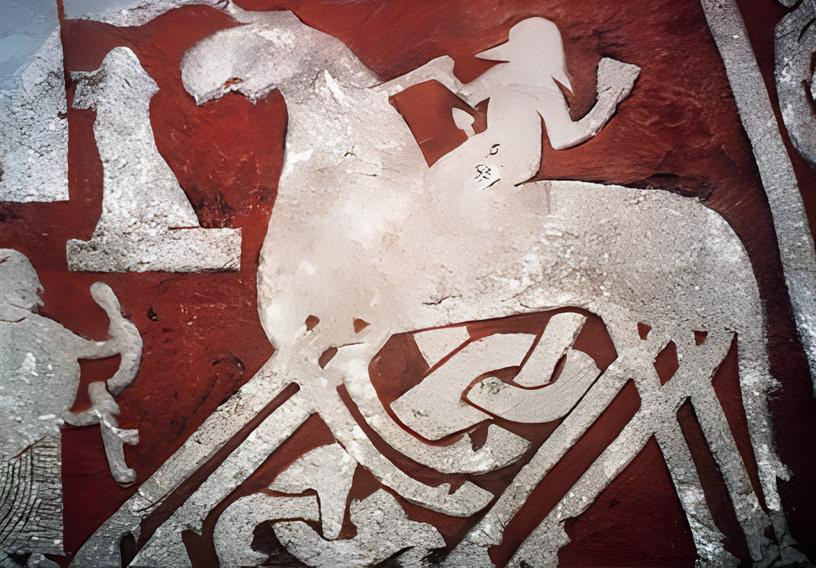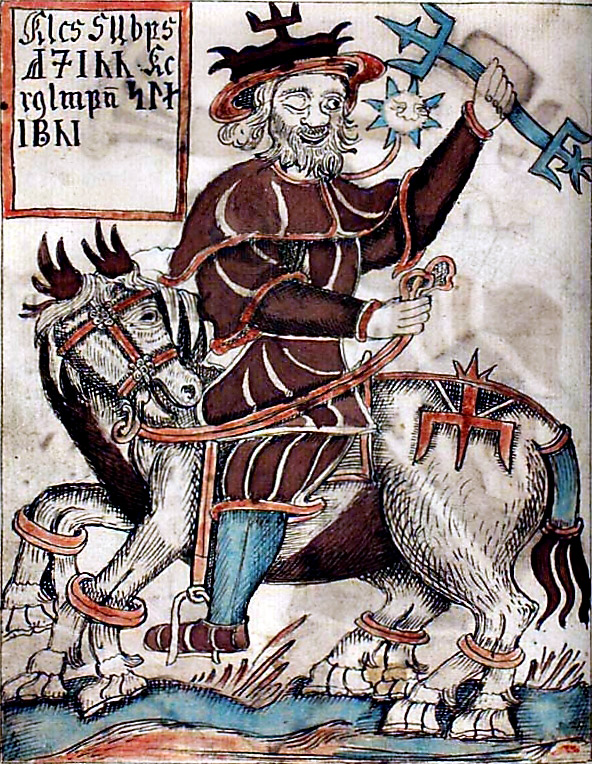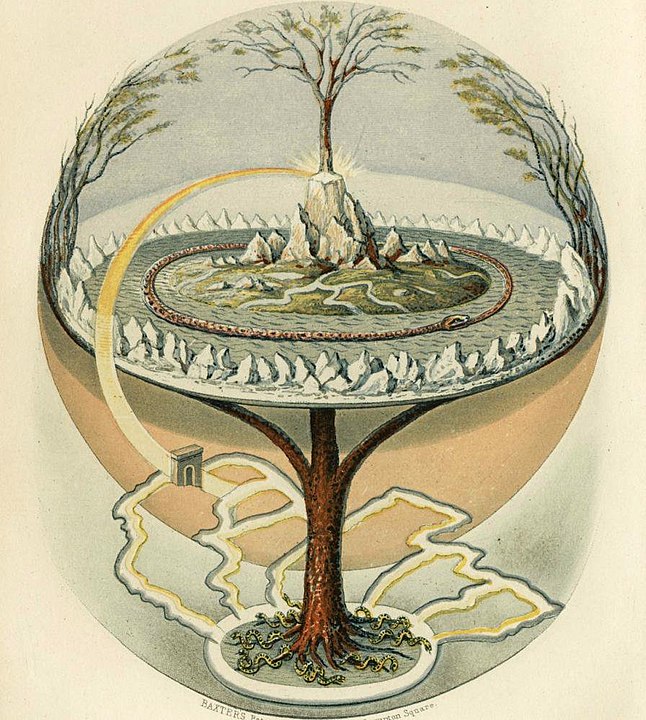Sleipnir, meaning “the slipper or slippy,” is the horse of the god Odin, the supreme Ase. Its coat is gray, supported by eight legs, and its runes are engraved on its teeth. No other horse is swifter than Sleipnir, capable of riding through the air and overseas. Primarily a shamanic creature, Sleipnir enables the supreme Ase to travel between different worlds.
Sleipnir’s parentage is unusual. According to the most well-known myth, the giant builder (jotunn or jötunheimr), disguised as a horse, offered to build the gods a protective wall around their realm, Asgard, in exchange for the sun, the moon, and the goddess Freyja. The gods agreed but required the wall to be completed in an impossibly short time. To fulfill this condition, Loki, the trickster god, transformed into a mare and distracted the giant’s horse, resulting in the birth of Sleipnir.
Sleipnir: Key Takeaways
- Odin’s Steed: Sleipnir is most famously associated with Odin, the Allfather of the Norse pantheon. Odin is often depicted riding Sleipnir across the sky and into the realm of the dead, known as Hel.
- Eight Legs: Sleipnir is distinctive for having eight legs, a unique feature among horses. This characteristic is often mentioned in various Old Norse texts, including the Prose Edda by Snorri Sturluson.
- Symbolism: The number eight was significant in Norse mythology, and Sleipnir’s eight legs are often interpreted as a symbol of strength and speed. The horse was renowned for its ability to traverse great distances and realms.
- Role in the Prophesy of Ragnarok: Sleipnir is mentioned in the context of the prophesied events of Ragnarok, the apocalyptic battle in Norse mythology. It is said that during Ragnarok, Odin will ride Sleipnir to the battlefield.
Roles of Sleipnir

Sleipnir is also a psychopomp horse that carries fallen warriors to the Valhöll. In his company, Odin crosses Bifröst, the rainbow bridge that links Asgard and Midgard and whose guardianship is entrusted to the god Heimdall, who hears the grass grow and every leaf fall, who sees to the ends of the world and needs no sleep. They ride to the battlefields of men, and Sleipnir escorts the valiant, fallen warriors—the Einherjar—to his master’s prestigious hall, the Vallhöll. There, the Valkyries, Odin’s daughters, welcome them and offer them mead from the goat Heiđrún (Heidrun), who perched on the palace roof and grazed on the tender shoots of the Yggdrasil ash tree.
This psychopomp function is reflected in pagan aristocratic funeral customs, where one or more horses are buried or cremated near the deceased.
Sleipnir, along with his son Grani, serves as the mount of Sigurd, a legendary hero in Norse mythology and the Nibelungenlied. Sleipnir is the only horse in Norse mythology capable of reaching the realm of Hel, the guardian goddess of the dead. When Baldr dies, Hermod, another son of Odin, borrows Sleipnir to travel to Hel and plead with the goddess to allow Baldr’s return.
Sleipnir is closely tied to the world tree Yggdrasill, supporting the nine worlds of Viking cosmogony. Like the tree, Sleipnir can travel and connect the worlds. Every day, Odin rides him to the gods’ council held at the base of Yggdrasil, near the source of Urđr. When Odin hangs for nine days and nights on the tree to gain knowledge of the runes, Sleipnir is initially tethered to the ash.
During the winter solstice, Sleipnir leads the god’s wild hunt across the sky and woods, galloping ahead of the Valkyries and the Einherjars. On the day of the Twilight of the Gods, the fateful Ragnarök, Sleipnir, leads his master Odin into battle, adorned with a golden helmet.
Sleipnir is the son of Loki, the only one of his “monstrous” children that the gods keep with them. The other three children, born with the giantess Angrbođa (Angrboda) of Jötunheimr—Fenrir the wolf, the serpent of Midgard, and Hel, the goddess of death—are deemed dangerous and are cast away. The serpent is thrown into the sea, the wolf is chained, and Hel is relegated to the realm of the dead, becoming its guardian.
The Edda: A Collection of Norse Mythology

The Edda is a comprehensive collection of Norse mythology, and it is one of the primary sources mentioning myths related to Sleipnir. In the 13th century, the Icelander Snorri Sturluson wrote it. Snorri, born in 1179 in Hvamm, in the region of Dalir, western Iceland, came from an ancient and influential family. He left his family at a young age to live with Jon Loftsson, one of the island’s most powerful leaders, in Oddi, one of Iceland’s main intellectual centers.
Snorri likely learned Latin and gained profound knowledge of Norse literary tradition while living with Jon Loftsson. As an adult, he married Herdis, Bersi’s daughter, a wealthy landowner. Snorri’s fortune grew rapidly, and he became a prominent political figure. In 1218, he responded to King Hakon of Norway’s invitation and stayed at the king’s court for two years. However, upon his return to Iceland, he became embroiled in the island’s clan conflicts over Norway’s attempt to extend its sovereignty over Iceland.
His situation in Iceland became perilous, prompting him to return to Norway, where he stayed for another two years amid difficult circumstances. Eventually, he returned to Iceland, defying King Hakon’s ban. Considered a traitor, he was assassinated on the king’s order on September 23, 1241.
Sleipnir is a crucial part of several myths, most notably the tale of how it was born due to a deal struck between Loki and a builder working on a fortification for the gods.
Snorri, a politician, aristocrat, and remarkable poet proficient in the art of skaldic poetry, wrote the Edda, probably during his first stay in Norway.
The Edda consists of four parts: the Prologue, Gylfaginning (“The Beguiling of Gylfi”), Skáldskaparmál (“Poetic Diction”), and Háttatal (“Enumeration of Meters”).
The first part, Gylfaginning, recounts King Gylfi’s visit to the gods in their realm of Asgard.
One day, King Gylfi offers a wandering woman who entertains him with a kingdom as large as four oxen could plow in a day and a night. However, the wanderer is actually an Ase goddess, and her oxen are the children she had with a giant. The territory plowed in the given time is immense. Surprised, King Gylfi decides to learn the origin of this power, and, taking the form of an old man, he goes to Asgard to question the gods themselves.
When he arrives at the hall of the Aesir, he claims to be a lost traveler named Gangleri and requests lodging for the night. He is welcomed and enters the hall, where many men drink, play, and fight. Then, he is brought before three hosts, the High One, the Equal of the High One, and the Third, who sit on thrones arranged one above the other.
“And stand now forth, while you ask; He who answers shall sit,” says the Most High.
Gylfaginning, chapter 2
Gylfi asks the High One, the Equal of the High One, and the Third Answer. The entire history of the world, from its origins to its final destruction, is recounted. The origin of time, the creation of the universe, the appearance of races, and the organization of the nine worlds around the ash tree Yggdrasill are described. Then, gods and goddesses are introduced, and for each of them comes the narrative of significant stories for the gods: the chaining of the wolf Fenrir, the conquest of the giantess Gerd by Skirir for his master Freyr, the role of Valhöll and the Einherjar who inhabit it, the origin of Odin’s steed…
Then said Gangleri: “Who owns that horse Sleipnir, or what is to be said of him?” Hárr answered: “Thou hast no knowledge of Sleipnir’s points, and thou knowest not the circumstances of his begetting; but it will seem to thee worth the telling.“
Gylfaginning, chapter 42
Sleipnir is associated with Asgard, which is one of the Nine Worlds in Norse cosmology and the realm of the Aesir, the principal group of gods.
Some Myths About Sleipnir
The Birth of Sleipnir

The main myth that has come down to us and is outlined in the Gylfaginning, the first part of the Edda, concerns the birth of Sleipnir.
As the gods have established themselves in their realm of Asgard and have built twelve magnificent palaces with roofs of gold and silver, a builder, accompanied by his only horse, comes to them. He then proposes to build a strong and impregnable enclosure to protect the palaces in three seasons (a Viking season lasting six months). In exchange for wages, he demands the moon Máni and his sister Sol, the sun, as well as the goddess Freyja.
Odin agrees to the proposal after consulting Loki and extending the deadline by one season. Furthermore, the builder can only use the horse that accompanies him and is named Svadilfari (Svaðilfari) to help him.
So, the builder gets to work. The days pass. The work progresses quickly and well, as the horse Svadilfari has prodigious strength that allows it to carry an enormous amount of rock. Also, when summer approaches and the allotted time is coming to an end, the fortress is almost complete.

Three nights before the deadline expires, the Supreme Ase summons all the gods. They remember that it was Loki who advised and urged them to accept. The gods seize him and demand that he find a solution. Odin is the most vehement, and he promises Loki the worst torments if he does not get them out of the predicament where his advice has led them. Loki gets scared, gives in, and promises to ensure that the builder does not fulfill his contract.
The next night, Loki uses his power of metamorphosis and takes the form of a spirited mare in heat. Then, he places himself in the path of Svadilfari. In vain, the builder tries to restrain his horse. It tears off the harness and ties, then rushes towards the mare. They gallop into the forest and stay there all night.
The builder has lost. He cannot complete the fortification within the imposed time. Faced with this failure, his fury becomes such that he can no longer hide his true nature. As a man, he transforms into an impressive ice giant. The gods, alarmed, step back. Odin raises his spear (Gungnir) high in the sky and calls for Þórr. The god, who went to fight trolls and other creatures, appears and, with a blow of his hammer, Mjöllnir, mercilessly smashes the skull of the belligerent giant.
Sometime later, Loki, the hermaphrodite giant with a thousand appearances, gives birth to a splendid foal: Sleipnir.
Sleipnir’s eight legs and its ability to traverse different realms symbolize not only speed but also transcendence and the interconnectedness of the cosmos.
Other Myths

Sleipnir also appears in other myths.
In the one that recounts the death of Baldr, Hermod, another son of Odin, rides Sleipnir to reach the realm of Hel. Hermod (Hermóðr) rides for nine nights and crosses increasingly dark and cold worlds until he reaches the edge of the Gjöll River, whose water is so icy that it seems to carry knives. Hermod then crosses Gjallarbrú, the golden-covered bridge that spans the river, and gallops until he reaches the gates of the realm of Hel. These are immense gates covered in gold. Hermod tightens the straps of Sleipnir and spurs his mount. Sleipnir leaps and jumps over the gates, not even brushing against them.
In a myth reported in the Skáldskaparmál, the second part of Snorri Sturluson’s Edda, Odin, wearing his golden helmet, rides Sleipnir and reaches the dwelling of the giant Hrungnir. He asks who this man is and what this marvelous horse is. Odin then bets his head that no horse as good as his can be found in all of Jötunheimr.
The giant retorts that his horse, Gullfaxi, is much faster. He mounts his horse in rage at Odin’s conceit and races Sleipnir, not realizing that he is entering the gates of Asgard because he is so focused on winning. Odin then invites his rival to drink; the giant gets drunk and begins to insult and threaten the gods. The Aesir then calls Thor for help. He kills the giant and entrusts his horse Gullfaxi to his son Magni.



